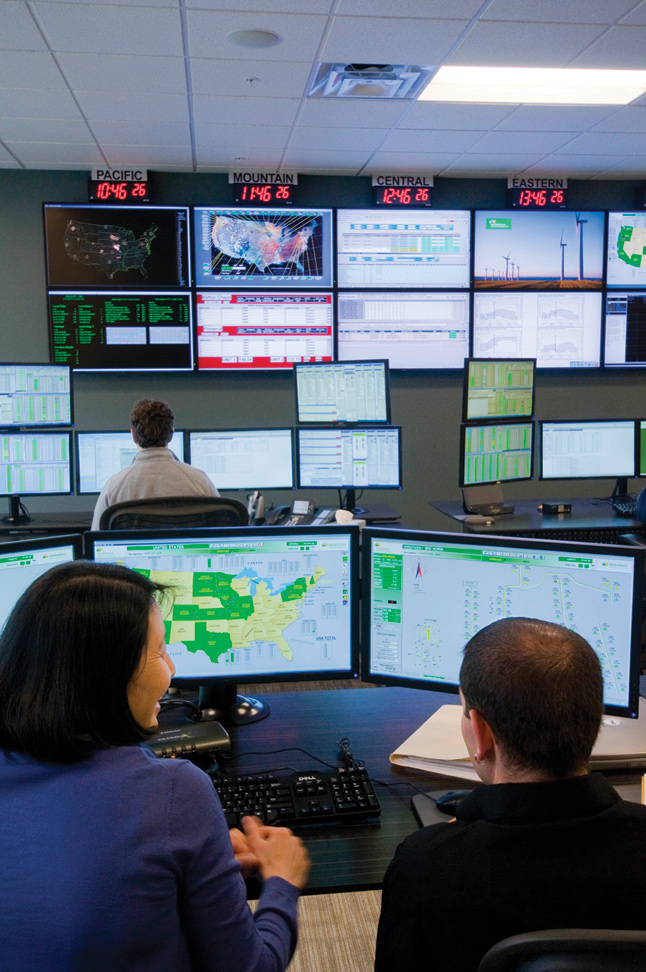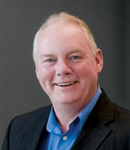Iberdrola Renewables provides wind energy globally, with their U.S. headquarters located in Portland, Oregon. Their operation is staffed 24/7/365 to manage their huge network of wind farms. It is vital for the organization to organize their energy distribution, scheduling, and dispatch to manage the green energy supply to their customers. They currently generate over 3,500 megawatts of wind power and other energy in 20 states with the goal of adding 1,000 megawatts each year – more than any other U.S. energy supplier.
Energy at the Speed of Wind
Wind energy is very abundant in many parts of the U.S. and does not need to be produced, so there will always be a constant supply. It is a form of solar energy that is pollution-free and renewable. This is likely the reason why wind energy is the fastest-growing source of energy worldwide. Additionally wind projects are entirely in line with President Obama’s pledge to create millions of ‘green’ jobs. As the largest provider of wind energy in the world and the second-largest provider in North America, Iberdrola Renewables is playing a key role in supporting U.S. government’s goal of achieving national energy independence.
At Iberdrola Renewables, our wind farms are professionally staffed 24/7/365 to provide energy management, scheduling, and generation dispatch capabilities. This helps our customers to manage risks and uncertainty in the natural gas and power industries while fulfilling energy requirements with sustainable and clean power. Originally called PPM Energy and part of Scottish Power, our company began operating in Oregon in 2001 with 12 employees. As of 2010, more than 850 workers throughout the United States maintain, develop, build and operate more than 3,500 megawatts of wind power and other energy facilities in 20 states with a goal of adding about 1,000 megawatts of new renewables each year – more than any other renewable energy supplier in the U.S.

Iberdrola Renewables manages over 3,500 megawatts of power from their offices in Portland, Oregon
Our latest operation in the Iberdrola Renwables fleet is the National Control Center, a nerve center in the wind industry located in Portland, Oregon. In a room that looks a little like Mission Control, our systems analysts oversee every turbine at every wind farm throughout the country, 24-7. They monitor the performance and efficiency of every turbine and keep an eye on approaching storms to warn technicians in the field to get to safety before harsh weather hits. They even help scientists conduct groundbreaking wildlife research at wind farms. And, they help the nation’s various transmission system operators enhance grid reliability to help keep the lights on – no matter what the obstacles or challenges might be.
SCADA System
The SCADA system supplied by PcVue is a vital element of the control center. Each wind turbine has a control box containing a programmable logic controller (PLC), control boards, power converter, and I/O device at the top. Sensors for wind speed, shaft rotation speed, wind direction, etc. collect and transfer data to the PLC. By determining the wind’s direction, the control system can use a motorized yaw gear to turn the entire wind turbine in the proper wind direction for maximum power generation. All wind turbines are connected to a Local Area Network (LAN), with each wind tower’s control box using Ethernet to link to the base of the tower where there is a fiber-based, redundant ring LAN connection. The LAN is connected to a remote control station running a control system that manages and collects data, adjusts turbine settings, and provides intelligent alarm, troubleshooting, and reporting capabilities via a central data center and control facility located in Portland, Oregon.
The SCADA connects individual turbines, substations, and meteorological stations to the central control room as well as operator visibility to supervise the wind farms as a whole. SCADA operators can determine corrective paths as needed from the record of activity they are seeing on a constant basis. It also records error signals, energy output, and availability and offers the capability to put in place any compliance requirements and control reactive power production, voltage, and power factors – allowing for the management of wind farms’ contributions to network voltage and frequency control. It also allows operators the capability to manage power output based on real-time grid requirements.
Flexible Architecture
The SCADA system communicates with the turbines via a communications network that almost always uses optical fibers. Iberdrola Renewables uses multiple turbine types and each turbine supplier provides their own control/HMI system. A major advantage of the SCADA system is that it is turbine supplier agnostic and not tied to any particular PLC vendor, so that it can provide data reporting and analysis formats, irrespective of turbine type.
This was of particular importance to us because our wind farm operators use multiple turbine types and a wide variety of PLCs. Additionally, our team really liked the user-friendliness of the system we chose and the ease of configuration. Its ability to ‘iconize’ animated mimics and the use of pop-up windows also reduced the task of overlaying crucial information and helped simplify the view for our team.
Also, the creation of templates for contents and behavior associated with each mimic and GUI (graphical user interface) animation ensure consistency of the window display. We use multi-level access rights and menus associated with each user to ensure that navigation within the application is tailored to the needs and the permissions of each individual. This provides a layer of security, traceability and control of users’ actions.
We have been in the global energy business since 2000. In the past – with a small number of wind turbines transmitting into the grid – it was a relatively easy data entry process. Currently, congestion has become a very big issue, with wind energy suppliers balancing energy production with available transmission injection points. Requirements are quite strict; thus, we have designed an integrated system with a curtailment of setpoints in order to manage the generation profile on a real-time basis. We are also working towards a more scalable system to meet the next generation of renewable energy transformation. And, we’re installing wind turbines to operate in harmony with various forms of energy, including nuclear, solar, hydro, and other energy sources in a ‘netting’ arrangement to optimize performance – very much on the cutting edge.
In order to manage our growing business, we have developed fiber-optic networks on our wind farms in the U.S. along with a state-of-the-art National Control Center facility in Portland. A very similar system is also present at our facilities in Toledo, Spain (outside Madrid), called CORE (Renewable Energies Operation Center). In each case, there is a central facility whereby our SCADA system is able to remotely access facilities throughout the country and access alarm and event conditions.

The National Control Center SCADA system
monitors wind generation across 20 states
Our management of multi-station configurations uses the SCADA system’s advanced tools to ensure the coherence of the configuration data and deployment on all of the stations, especially for all of its geographically remote applications. Moreover, the centralized configuration provides the capabilities for the management and traceability of the various versions of applications and associated changes. It also supports automatic updating of the stations that make up the supervisory system. And, consistency checks of the versions in use are automatically run at each start-up of a station on the network.
Our Operation Center has a global potential to supply energy service to any interested owner, with no geographical limitations. In the U.S. we are currently producing 3,500 megawatts of wind power over 35 independent power plants. Iberdrola maintains 2,479 wind turbines. Each wind turbine supplies about 300 to 350 data points, which equates to approximately 700,000 to 850,000 I/O data points on nearly two dozen servers.
To cope with the diverse demands of maintaining our wind farms, the application alarms are highly configurable, permitting alarm messages to be printed, viewed in alarm lists and archived. Operators configure alarm behavior using groups, filters, sorting, acknowledgement and masking. They also create alarm counters and associate specific actions with an alarm. Alarms can be acknowledged by operators directly from mimics and automatically broadcast to all nodes on the network.
Iberdrola Renewables is using OPC (and others) as the communications protocol to pull data from the various PLCs. Many wind farm applications often use OPC (OPen Connectivity) and a special driver to seamlessly communicate with disparate systems. We use the system’s OPC Data Access Client and OPC DA XML Client for exchange of real-time data with communication servers, and OPC DA Server to facilitate data exchange with third-party applications. All of the data acquisition that occurs is routed back to the National Control Center.
I manage the teams developing integrated control systems. We chose PcVue’s software for the Portland National Control Center, mainly because they had already proven to be user-friendly and highly functional in our Spanish operations.
The system proved reliable, scalable, and easy to configure, and CORE had been kept up and running quite successfully. A single user view that allows an easy visual display and overall management of the myriad systems in place from PLC, HMI and the control system equipped on the turbines is also a big plus. As we monitor avian migration and weather in addition to controlling and managing our turbines, we needed a system that would provide a simple, easy-to-read GUI so that we can react at a moment’s notice.
The new SCADA software integrates and connects with the wind turbines via the GUI interface acting as a light client to the application and managing up to 2.5 million data elements. This configuration provides the operator all the necessary information about the turbine signals. We are utilizing this distributed client-server architecture with redundancy to ensure that the design is fault tolerant. Using these built-in redundancy features, we were able to ensure continuity of data collection in the event of a system component failure.
The system also supports dual networks, both for communication with field equipment and among PcVue stations. Each component and each station in the configuration has a validity status to enable operators to view the condition of the system in real time. These client stations are communicating via OPC with the redundant communication front-ends connected to the 1,000 Mbps TCP/IP Ethernet network. Each front-end is able to receive up to 60,000 I/Os.
Using this architecture, our operators can also see specific details of the remote wind farm data in a realtime display. Given the large volume of information – approximately 350 signals per turbine – and in order to facilitate operation and maintenance of the facilities, the supervision appears in two levels.
The first supervision level facilitates an overview of the most relevant alarms, values and counters – enough to supervise the turbines in a normal situation and detect failures that need to be corrected. A second, more detailed supervision level – triggered on an operator’s request – enables the supervision of all the turbine’s data selected so that operators can immediately diagnose, with accuracy, failures that occurred and determine the necessary corrective action. Received data can be processed as set points, historical storages, alarm management, trending, etc.
The control system in each installation collects the main operational information from the generators and their associated substations. The control system is connected to the Control Center through a remote communications channel, and therefore, facilitates maintenance tasks. The National Control Center receives this information and processes it into an organized and simplified structure that permits easy identification and diagnosis of failures.
This diagnosis triggers the appropriate actions for its solution: Remote reset or activation of local maintenance teams. As a result, average down time decreases, thus increasing availability while our operators can see in depth data from the remote wind farms.
Iberdrola Renewables in the U.S. completed the transitioning by the end of 2010, and so far, all expectations have been met and the system is working very well. This will become the standard process for all later facilities, so that it becomes their typical “out of the box” solution.

Harm Toren, Managing Director, Head of Operations Services for Iberdrola Renewables, is an energy industry professional based in Portland, Oregon. Harm started his energy career in 1976 with the U.S. Navy submarine service where he ultimately qualified as Nuclear Engineering Officer of the Watch. Entering civilian life in 1984, he worked in the utility energy sector at nuclear plants such as Quad Cities, Millstone, and Shoreham. Harm has started up and successfully operated two energy-based consulting companies along with working directly with utilities and independent power producers. Harm holds an MBA in Finance & Global Business Strategies from Utah State University.








